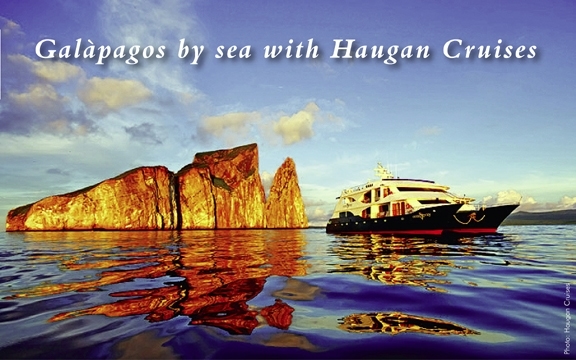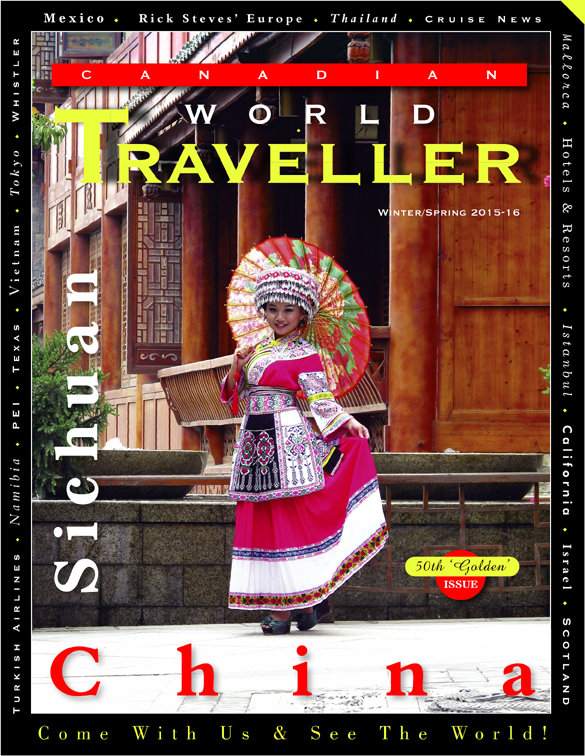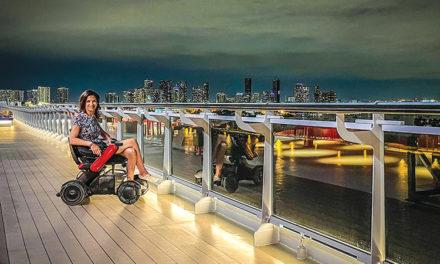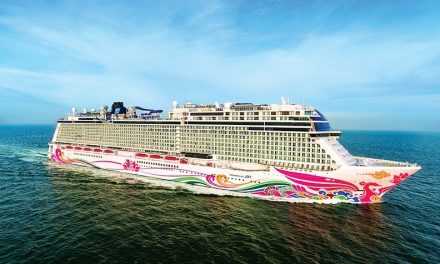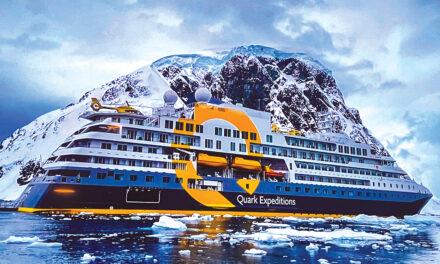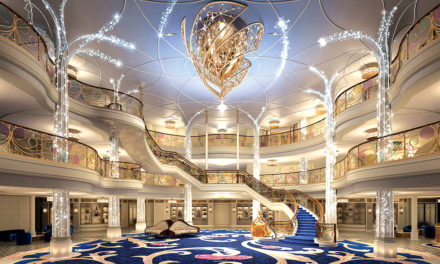Galàpagos, Ecuador
Galàpagos by sea with Haugan Cruises
Article & Photography by Johanna Read, TravelEater.net

The sea lions frolic. The blue footed boobies preen. The flightless cormorants intertwine their necks in a mating dance.
As we drift along shore, new animals come into view. Penguins look at us. A marine iguana searches for algae. Sally Lightfoot crabs — even redder than the dinner plate variety — crawl along the rocks. This is a typical two minutes on a panga (Zodiac) ride during a Galàpagos cruise.
As you might expect, life aboard a Galàpagos cruise is very water-oriented. There are, of course, daily excursions onto one of the twenty islands of this archipelago on the equator. Depending on which island you visit, you’ll also see many land-based animals like the finches that sparked Darwin’s theory of evolution. Easy to find are giant tortoises, lava lizards, land iguanas, as well as marine iguanas and sea lions that like to snooze in the sun. There are so many animals, it’s hard to know where to look.
On the water, it’s even harder to choose which animal to look at. There are animals everywhere, and if you’re exploring Galàpagos via cruiseship, you’ve chosen the ideal way to see them all.
Kitted out in snorkelling gear and wetsuit, I flip over the side of the panga into the refreshing water at Punta Vicente Roca, on the northwestern side of Isabela Island.
I’m startled by a large eagle ray, but he barely notices me. I know the names of only a handful of the fish that surround me: sergeant major, parrotfish, and king angel.
As I make my way closer to the rocky wall of the island, suddenly I’m surrounded by turtles, big ones who lazily watch the bubbles from my snorkel. I telepathically say to one, “hey, don’t you know you’re not supposed to get that close to me?!”
He looks at me and flicks his long tail as he drifts by, as if to say “the rules apply to you, turista, but not to me”.
Best way to see the Galàpagos
A cruise is the ideal way to see the Galàpagos, as most animals are spread out across the 13 main islands and the seven smaller ones. Most locations are accessible only by boat.
While you can see a lot on a day cruise from a hotel, to really understand Galàpagos’ diversity you need to visit more than one island. Islands are quite far apart from each other. The only practical way to see more than one or two is by sleeping comfortably aboard your cruise ship on the inter-island crossings.
You have many choices for cruises, but the smaller your ship, the more you will see. This is because with fewer passengers, the logistics are easier for getting everyone off the ship and into small pangas. Panga is the local name for a small boat, in this case the tough inflatable Zodiacs which bring you ashore, to the best snorkelling and kayak locations, and alongside steep rock walls where animals make their homes.
If you’re looking for comfort and stability, a catamaran is your best cruiseship choice. The waters between the Galàpagos islands can get quite rough, and the shallower draft and two hulls of the catamaran make it more stable than most single-hulled ships. If seasickness is a major concern, choose a catamaran or the largest (90-100 passenger) ships allowed in Galàpagos.
Seasickness tips:
Pack pressure-point wristbands (available at any drug store).
Choose a lower mid-ship cabin, as you’ll feel even less motion.
Ensure your cabin has a private balcony so that you can enjoy the fresh air and gaze at the steadying horizon — even in your pajamas — if you feel a little queasy.
Galàpagos waters are roughest from June to December, with June to August having the choppiest waters near the main island of Santa Cruz.
Choosing your Galàpagos cruise
There are three different classes of Galàpagos cruiseships. Aside from price, the main difference between them is comfort and quality. When assessing costs, be sure to determine whether the cost of airfare from the mainland is included in the price.
Tourist class: smaller, with basic amenities. Cabins are near the engine room and are often noisy and smell of diesel. Cabins are small, with bunk beds. Bathrooms are usually shared, with limited hot water. Food is budget. Average speed is 8 or 9 knots, so itineraries are limited. Guides will have some English, but are likely not fluent.
First class: bigger ships with more communal space and bigger cabins with private baths and sometimes with balconies. Food is adequate. Air conditioning is generally quiet and throughout the ship. Guides are fluent in English. Most islands are included in itineraries.
Luxury class: fast boats with the highest standard of design for stability and comfort in the Galàpagos (the calmer Caribbean and Mediterranean fleets have more luxurious boats). Best quality and selection of food and wine, with several places to dine and lounge. Also included are snorkelling equipment, wetsuits and kayaks, which will be in good condition. An outdoor jacuzzi on deck lets you warm up after your snorkel. Itineraries are not restricted by distance. The luxury ships hire the most experienced and skilled guides and crews.
Catamarans are the most spacious of all the ships in Galàpagos waters, because cabins and public spaces are spread across the ”bridge” connecting the two hulls. Catamarans are very comfortable and remarkably stable, even on the rough inter-island crossings.
Haugan Cruises
Haugan Cruises has Galàpagos’ newest fleet of catamarans, and each of their three ships takes just 16 passengers.
Haugan’s cabins are large — the brand new (November 2015) Petrel even has two suites. Every cabin has a private balcony and a spacious bathroom with L’Occitane amenities. The ships are equipped with several dining and lounging areas, a jacuzzi on the top deck, and all the equipment you need for snorkelling and kayaking amongst Galàpagos’ water animals.
The little luxuries make it ideal. For example, after snorkelling on a day cruise, you’ll need to change out of your bathing suit in a cramped bathroom. Aboard a Haugan cruise, you’re greeted with hot chocolate and a big towel after your swim. You can take a dip in the jacuzzi before heading back to the hot shower in your cabin before dressing for dinner or your shore excursion.
Best guides, on land and sea
By sailing with Haugan you’ll have some of Galàpagos’ top guides. The best guides have their pick of boats, and Haugan is one of the very best. I learned an incredible amount from my guide, Javier. Haugan’s guides are all bilingual (or more), have a very high level of education, and are adept at understanding and adapting to each guest’s interests.
Javier makes a point of ensuring I see all the unique underwater treasures of Galàpagos. During one snorkel at Elizabeth Bay, he tells me exactly where to dive deep so I can see a seahorse — my first outside of an aquarium. He teaches me so much about the seahorse’s habits and habitat, that a few minutes later I find my own seahorse clinging to some seaweed in the gentle current.
On land and at sea, Huaguan Cruises is the ideal way to see Galàpagos.
www.haugancruises.com
Johanna Read is a Vancouver-based freelance writer and photographer specializing in travel and food. Follow Johanna on:
Instagram @TravelEaterJohanna
Twitter @TravelEater.
www.TravelEater.net
Click on cover to view published article

